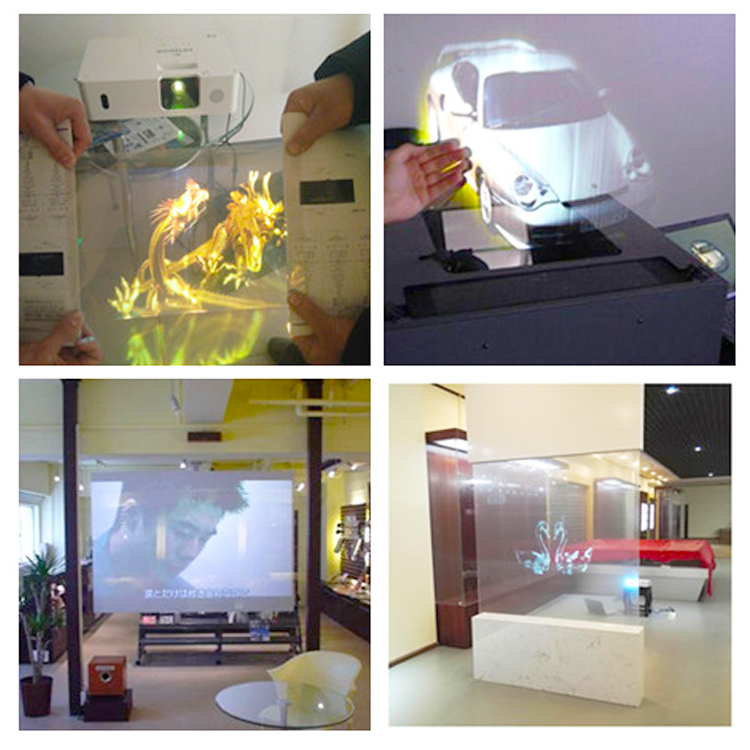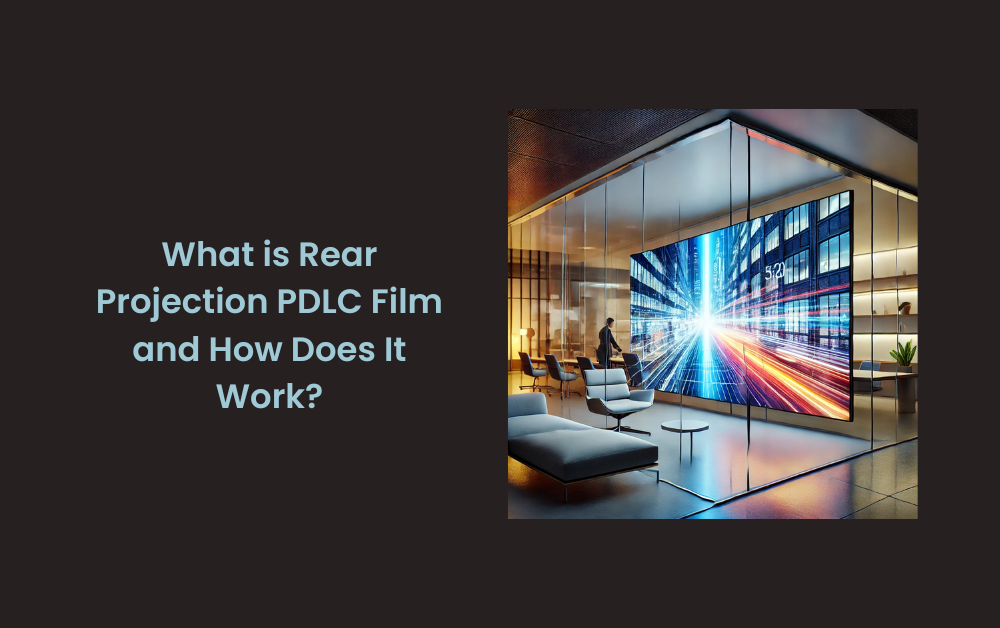What is Rear Projection PDLC Film and How Does It Work?
Rear projection PDLC film is a fascinating innovation in the world of display technology, offering unique features that make it an excellent choice for various applications. Whether you’re looking to create a private viewing area, an interactive display, or a high-tech conference room, understanding what rear projection PDLC film is and how it works is essential. This comprehensive guide will explore the key aspects of this technology, providing you with valuable insights to help you decide if it’s the right solution for your needs.
1. Introduction to PDLC Technology
To fully grasp the concept of rear projection PDLC film, it’s important first to understand the basics of PDLC technology. PDLC stands for Polymer Dispersed Liquid Crystal. This technology involves the dispersion of liquid crystal droplets within a polymer matrix, creating a material that can switch between transparent and opaque states when an electric current is applied.
PDLC technology is widely used in smart windows, privacy glass, and various display technologies, offering a dynamic way to control light transmission. By altering the alignment of the liquid crystals through an electric charge, PDLC films can change from a frosted, opaque appearance to a clear, transparent one, enabling a wide range of applications.
2. What is Rear Projection PDLC Film?
Rear projection PDLC film combines the properties of PDLC with the ability to project images onto the film from behind, creating a versatile display solution. When installed on glass or other transparent surfaces, this film allows you to switch between a regular glass window and a high-definition projection screen at the flick of a switch.
In its frosted state, the film scatters light, making it ideal for rear projection. This means that images projected onto the film are visible from the front, creating a clear and vibrant display. When the film is switched to its transparent state, it acts as a regular window, offering an unobstructed view.
3. How Does Rear Projection PDLC Film Work?
The working principle of rear projection PDLC film revolves around the manipulation of light and liquid crystals. Here’s a step-by-step breakdown of how it functions:
Step 1: PDLC Film in Off State (Opaque)

In the absence of an electric current, the liquid crystal molecules within the PDLC film are randomly aligned. This random alignment scatters light, causing the film to appear opaque or frosted. This state is perfect for rear projection because the frosted surface diffuses the projected light evenly, creating a clear image on the front side of the film.
Step 2: Rear Projection
In the opaque state, a projector placed behind the PDLC film sends light towards the film. Since the film is in its frosted state, it diffuses the light uniformly, displaying the image clearly on the film’s surface. This process allows viewers on the opposite side to see the projected content as if it were being displayed on a traditional screen.
Step 3: PDLC Film in On State (Transparent)
When an electric current is applied to the PDLC film, the liquid crystal molecules align themselves in a uniform direction. This alignment allows light to pass through the film without scattering, making it transparent. In this state, the film functions as a regular window, providing a clear view through the glass.
4. Applications of Rear Projection PDLC Film
The unique properties of rear projection PDLC film make it suitable for a wide range of applications across various industries. Here are some of the most common uses:
Corporate and Commercial Displays
Rear projection PDLC film is ideal for creating dynamic presentations and displays in corporate environments. Conference rooms can be transformed into high-tech spaces with switchable privacy screens that double as projection surfaces.
Retail and Advertising
In retail, this film can be used to create attention-grabbing storefront displays. The ability to switch between a transparent window and a display screen allows retailers to maximize their window space, showcasing products during the day and playing promotional videos at night.
Automotive Displays
The automotive industry is also exploring the use of rear projection PDLC film in vehicle displays. This technology can be integrated into car windows or sunroofs, providing drivers with real-time information or entertainment without obstructing their view.
Architectural Design
Architects and interior designers use rear projection PDLC film to create versatile spaces. For instance, a glass wall in an office can serve as both a transparent partition and a projection screen for presentations.
Entertainment and Events
In the entertainment industry, this film is used for interactive displays, stage setups, and immersive environments. Event planners can create stunning visual effects by projecting onto transparent surfaces that can switch between clear and opaque.
5. Benefits of Using Rear Projection PDLC Film
There are several advantages to using rear projection PDLC film, making it an attractive option for various applications:
Versatility
One of the main benefits is its versatility. The film can be used in a wide range of environments, from corporate offices to retail spaces and even in vehicles. The ability to switch between transparency and opacity adds to its functionality.
Space Efficiency
Rear projection PDLC film allows you to maximize space. Instead of requiring separate areas for windows and display screens, this film combines both functions in one, saving space and reducing clutter.
Privacy Control
This film provides an excellent solution for privacy control. In offices or meeting rooms, you can instantly switch from a transparent window to an opaque screen, ensuring confidentiality during important discussions.
Enhanced Aesthetics
The sleek and modern appearance of rear projection PDLC film enhances the aesthetics of any space. It adds a high-tech, futuristic feel to buildings and interiors, making it a popular choice for cutting-edge architectural designs.
Energy Efficiency
By reducing the need for separate lighting and display equipment, rear projection PDLC film can contribute to energy efficiency. The film’s ability to switch states also means that it can help regulate indoor temperatures by controlling the amount of sunlight that enters a space.
Durability
PDLC films are designed to be durable and long-lasting. They can withstand regular use without losing their functionality, making them a cost-effective investment in the long run.
6. Challenges and Considerations
While rear projection PDLC film offers numerous benefits, there are also some challenges and considerations to keep in mind:
Cost
The initial cost of installing rear projection PDLC film can be higher than traditional display options. However, the long-term benefits, such as space savings and versatility, often justify the investment.
Projection Quality
The quality of the projected image depends on several factors, including the type of projector used and the ambient lighting conditions. In bright environments, the image quality may be compromised, requiring additional measures such as using a more powerful projector or controlling the lighting.
Installation
Proper installation is crucial for optimal performance. The film must be applied correctly to ensure even light diffusion and to prevent bubbles or wrinkles that could affect the projection quality.
Maintenance
Although rear projection PDLC film is durable, it requires regular maintenance to keep it in top condition. Dust, fingerprints, and smudges can affect both the transparency and the quality of the projected image, so the film must be cleaned regularly.
7. Installation and Maintenance
Installation Process
Installing rear projection PDLC film is a delicate process that requires professional expertise. The film is typically applied to glass or acrylic surfaces using an adhesive layer. It’s important to ensure that the surface is clean and free of any debris before application to prevent imperfections.
Once applied, the film is connected to a power source, allowing it to switch between opaque and transparent states. Proper alignment and smoothing are essential to avoid bubbles or wrinkles, which could interfere with the projection quality.
Maintenance Tips
Maintaining rear projection PDLC film involves regular cleaning to ensure optimal performance. Here are some tips for maintaining the film:
- Cleaning: Use a soft, non-abrasive cloth and a mild cleaning solution to wipe the surface. Avoid harsh chemicals that could damage the film.
- Avoid Scratches: Be careful not to scratch the film, as this could affect its appearance and functionality.
- Check Connections: Periodically check the electrical connections to ensure that the film switches states correctly.
8. Future Trends in Rear Projection Technology
The future of rear projection PDLC film is promising, with ongoing advancements likely to expand its applications and improve its performance. Some of the trends to watch for include:
Integration with Smart Home Systems
As smart home technology continues to evolve, rear projection PDLC film is expected to become an integral part of home automation systems. Imagine controlling your windows and display screens through a single app, with the ability to switch between transparency and projection at will.
Increased Energy Efficiency
Future developments in PDLC technology may lead to even greater energy efficiency. Researchers are exploring ways to reduce the power consumption of PDLC films, making them an even more sustainable choice for modern buildings.
Improved Image Quality
Advancements in projection technology are likely to enhance the image quality of rear projection PDLC film. Higher resolution projectors, better contrast ratios, and improved color accuracy will contribute to more vibrant and lifelike displays.
Expanded Applications
As the technology becomes more accessible, we can expect to see rear projection PDLC film used in a wider range of applications. From interactive museum exhibits to high-end retail displays, the possibilities are endless.
9. Conclusion
Rear projection PDLC film represents a cutting-edge solution in the world of display technology, offering a unique combination
of versatility, space efficiency, and aesthetic appeal. By understanding how this technology works and where it can be applied, you can make an informed decision about whether it’s the right choice for your needs.
Whether you’re looking to create a dynamic presentation environment, enhance the privacy of your office, or add a futuristic touch to your architectural design, rear projection PDLC film offers a range of benefits that make it worth considering. As technology continues to advance, we can expect to see even more exciting developments in this field, further expanding the potential applications and capabilities of rear projection PDLC film.
By focusing on clear explanations, practical insights, and future trends, this guide aims to provide valuable information that can help you navigate the world of rear projection PDLC film with confidence. Whether you’re a business owner, architect, or technology enthusiast, understanding this innovative material will open up new possibilities for your projects.
Note :- Read more related blogs at https://articlestores.com/
